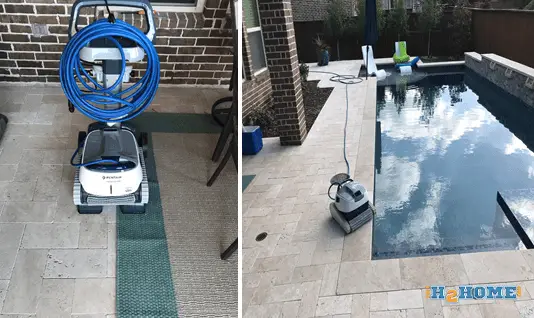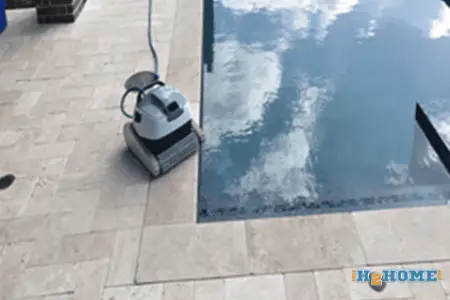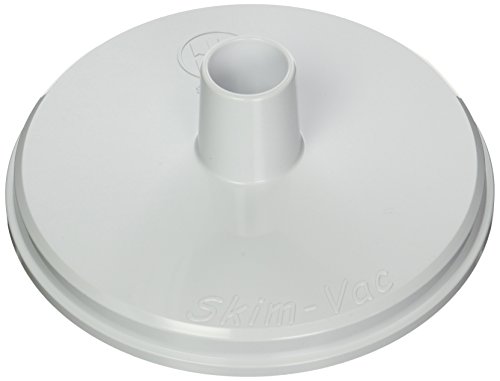Just like most things in life, your pool needs regular cleaning to stay clean and inviting. It needs to be able to handle dirt, dust, pollen, dead algae, leaves, and whatever else your environment throws at your pool.
In this article, I will walk you through the various types of pool cleaners so you can pick what is best for your needs.
Types of Cleaners
There are 5 main types of pool cleaners:
- Manual Vacuums
- Suction side pool cleaners that hook into your skimmer
- Pressure side cleaners popularized by Polaris
- Robotic cleaners powered by electricity
- In-floor cleaning built into the shell of your pool
I outline the pros and cons of each type of cleaner below to help you with your decision.
Manual Vacuums
What are manual vacuums
Manual vacuums are simple, effective, but require you to do the heavy lifting in cleaning your pools. Typically a manual vacuum consists of a hose that hooks into your skimmer that is connected to a vacuum head on the end of your pool pole, like this one:
No products found.
If you have a smaller pool and do not mind spending the time to vacuum your pool when it needs it, then I highly recommend manual vacuums for an affordable and effective means to clean your pool.
Manual Vacuums: Pros
Manual vacuums have many pros, primarily that they are so simple yet effective. There are few moving parts to break, they are the cheapest type of pool cleaner and the most efficient in allowing you to clean your pool in a short amount of time.
Manual Vacuums: Cons
The biggest con to manual vacuums is that it is the most labor-intensive. There are no fancy buttons, schedules, or anything else like some of the other pool cleaners. It only runs when you hook it up and vacuum your pool by hand.
Additionally, all of the dirt and debris that are sucked up by the vacuum goes through the hose and into your pool filter. This collects in your filter and shortens the time between filter cleanings and backwashing.
To alleviate some of this concern, I always recommend using a skimmer plate that allows you to keep the skimmer strainer basket in the skimmer to catch the larger debris before it makes it to your filter. Skimmer plates like this one must be compatible with your skimmer.
- Large skimmer vacuum plate with 1-1/2-inch straight adapter
- Fits Hayward swimming pool skimmer SP1082, 1084, 1085, 1075 models
- By utilizing the skimmer basket instead of the pump strainer basket, the...
- Simply attach the appropriate Skim-Vac to the vacuum hose located over the...
- Measures 7 29/32 inch diameter
Suction Side Pool Cleaners
The first type of automated pool cleaner invented were suction side pool cleaners and patents for this type of cleaner date back to the early 1900s. These types of cleaners are still widely used, albeit much improved from the initial versions.
Suction side pool cleaners utilize the suction side of your pool system, generally the skimmer. These are very similar to the manual vacuums with the main exception that the suction side pool cleaners move on their own randomly around your pool and do not require you to do any of the vacuuming by hand.
Below is a Kreepy Krauly Suction-Side Cleaner:
- Dive float directional system helps guide cleaner throughout entire pool...
- Automatic valve automatically regulates water flow to set the ideal travel...
- Roller strap maneuvers cleaner around steps and ladders for uninhibited...
- Cleaner wings help channel leaves, dirt and debris directly into filtration...
- Original "one moving part" design for years of dependable service - no...
Suction Side: Pros
Suction side pool cleaners offer you a break from manual vacuuming while being the least expensive type of non-manual cleaning, generally costing less than $500.
Some of the models will even cover the walls in addition to the pool floor similar to the more expensive types of cleaners.
Suction Side: Cons
Suction side cleaners can be easily clogged by leaves and are best suited for pools where the debris is primarily smaller like sand and dirt.
Just like manual vacuuming, the dirt and debris captured by the vacuum are deposited into your pool filter and require more frequent cleanings or backwashing of your filter.
Pressure-Side Pool Cleaners
Overview
In the 1970’s improvements in pool cleaner technology lead to the invention of pressure-side pool cleaners which utilize the water returning to your pool from the pump rather than the suction side of your pool system.
In 1973, the Polaris pool cleaner was released and quickly became widely used in backyard pools. These self-propelled cleaners were much quicker than the suction side cleaners and they had a bag to capture debris rather than putting it into your pool filter.
I grew up in the ’80s with a pool that had a Polaris pool cleaner. At one point we switched to a suction side cleaner when the polaris was not working but quickly switched back to the polaris for a speedier and better clean.
Pressure side cleaners are still widely used today and even with improvements they still resemble the original design.
- Designed to bring your in-ground pool powerful vacuum performance for a...
- Circulating an additional 40 gallons of water per minutes through it's dual...
- Works with all pool surfaces, sweeps and scrubs the pool's floor and walls...
- Powered by a booster pump (not included) that allows the cleaner to easily...
- All-wheel PosiDrive system with durable stainless steel drive chain...
Pressure-Side: Pros
Pressure side cleaners are much quicker than their suction side counterparts, and their debris bags allow them to handle leaves and other large debris better. Some models even have multiple bags to filter out smaller particles.
The booster pumps for pressure-side cleaners can be put on a separate timer to allow the pressure-side cleaning to be scheduled and not always on like suction cleaners.
Pressure-Side: Cons
Cost is one of the biggest cons to pressure side cleaners and they can cost $600+ and also usually require the purchase of a booster pump to supply the required water to operate your cleaner.
In addition to the initial purchase, the pressure side cleaners require the main pool pump to be running at a high speed as well as a booster pump which increases your electricity consumption and overall operating costs.
Lastly, pressure-side cleaners and their pumps have the most moving parts of all of the cleaner types which means there are more items to break on these types of cleaners.
Robotic Pool Cleaners
What are Robotic pool cleaners?
The most recent technology in pool cleaners are Robotic Pool cleaners and they have gained quite a bit of attention in the last 5-10 years. These cleaners are powered by electricity and run independently from the pool and filtration system.
If you’re looking to clean your pool without chemicals, read this article.
Just like the Polaris-type pressure side cleaners, robotic pool cleaners drive around your pool and walls cleaning dirt and debris. Generally, robotic pool cleaners have more sensors and electronics to better navigate your pool floor and walls than pressure side cleaners.
For in-ground pools that can store the robot safely outside of the pool, I highly recommend robotic cleaners.

Robotic: Pros
Being the latest technology, robotic pool cleaners generally perform the best out of all of the other pool cleaner types. They can navigate your pool floor and walls, scrub the tile line, and can even backup and navigate around objects in your pool.
The thing that I like best about a robotic cleaner is the ability to easily store it outside of the pool and out of the way of swimming and enjoying the pool. wants to look at a pool cleaner when it is not in use, and swimming around the cord and worrying about running into the cleaner can be annoying. When you are ready to clean your pool, just throw it in the water, let it run a cleaning cycle, pull it out, and store it for the next time.
Just like pressure side cleaners, robotic cleaners capture dirt and debris themselves and do not send the debris into your pool’s filtration system.
Unlike other cleaner types, a robotic pool cleaner runs independently from your pump. This can be useful and allow you to clean your pool during times when your pump is scheduled to be off. This can be a serious cost saving in terms of operating costs.
Robotic: Cons
Cost is one of the biggest cons for robotic pool cleaners, with most models costing $800 or more and can even get to $1,500 when you start adding Bluetooth, caddies, remote controls, and other features to them. Recommend getting a basic model without all of the costly party tricks.
While I listed the pro of being able to easily remove the robot when in use the cord supplying the robot power sits on top of the deck. If you want to leave the robot in the water all of the time or feel that the cord will be a tripping hazard, I would not recommend a robot cleaner.
Lastly, just like the pressure-side cleaners, there are a lot of moving parts and technology within a robotic cleaner that can go wrong over time.
In-Floor Pool Cleaner
Overview
In-floor cleaners use pop-up nozzles which pop up from the shell of your pool and use a stream of water to sweep dirt and debris in your pool towards a specialized drain for debris removal. This debris is collected in a containment system which must be emptied just like a skimmer basket.
Companies like Paramount are leaders in in-floor pool cleaning.
In-floor: Pros
In-floor cleaning systems offer the most hands-off approach to pool cleaning. Besides emptying the debris container, there is virtually nothing the pool owner must do. An in-floor system that is properly dialed in can be a thing of beauty.
In-floor cleaners can also keep areas like tanning ledges, connected spas, and hard-to-reach areas like stairs or barstools clean, unlike all other pool cleaner types.
Manufacturers will also speak to better water circulation since the cleaning nozzles act as returns when in use and return water to all parts of your pool and not just near the surface like traditional returns. I’m not completely sold on this benefit, but I could see it being somewhat useful if you were heating the pool.
In-floor: Cons
In-floor cleaners are the most expensive pool cleaning option by a large margin. Expect to pay $5,000 or more, with some setups costing over $10,000.
In-floor systems can only be installed when your pool is built and would be virtually impossible to safely retrofit a pool with all of the nozzles and drains required to properly use an in-floor system.
I mentioned earlier that an In-floor system can be a thing of beauty when it is properly dialed in, but in my experience, many times the in-floor systems are not always dialed in and require supplemental cleaning to capture spots the system misses. If you decide to go with an in-floor cleaner, ensure that your pool builder is very experienced in properly designing and installing the system.
Lastly, in-floor cleaners require no day-to-day involvement but they do have to be serviced and have the heads replaced, which can be more involved and expensive than other types of pool cleaner repairs.
Other Cleaner Types
I covered the 5 primary types of pool cleaners, but they are not the only way to keep your pools clean. These other types of pool cleaners can be supplemental to your primary pool cleaner to avoid the cons of those types of cleaners.
Solar Powered Skimming
Solar-powered skimmers harness the power of the sun to move a floating skimmer that moves across the surface of the pool collecting debris. These are gaining in popularity and are becoming more mainstream.
No products found.
I find these floating skimmers to be a bit pricey for only cleaning your pool at the surface, but they can be a great addition to a pool that does not have adequate skimming.
Cordless Rechargeable Vacuums
These types of vacuums are small battery-powered vacuums that attach to the end of your pool pole to suck up debris.
- CORDLESS: Rechargeable Lithium Ion Battery. Perfect for quick and easy...
- VERSATILE CLEANING: Includes a removable 7.5” vacuum head for general...
- RUN TIME: The lithium ion battery powered Catfish is designed to run up to...
- EASY OPERATION: Push-Button operation. Lightweight and easy to use by hand...
- WHATS INCLUDED: 7.5" Vacuum Head w/Soft-Bristle Brush, Wall Charger, (1)...
Depending on the battery, the run time for these is only adequate for a very small pool and I would not recommend them for your primary pool cleaning. They are great in that they are easy to use and quickly remove debris from areas like spas that cannot be reached by traditional pool cleaners.
Garden Hose Powered
These types of cleaners use the venturi effect to suck leaves and other debris into a bag, which is the same technology behind pressure side cleaners. Unlike pressure side cleaners, PoolSupplyTown Jet Vacuum Cleaner utilize the power of your garden hose and you will add water to your pool when using.
- This item DOES NOT come with pole. You need a standard 1-1/4" telescopic...
- Vacuum debris and brush pool at the same time. Ideal for frame above...
- Use water pressure from your garden hose to suck up debris in pool.
- The water pressure from your garden hose creates an Venturi effect inside...
- No ELECTRIC POWER needed. Package comes with an Assembly & Operation...
I have not had good luck with these types of cleaners and find them a bit frustrating to use, but they do work and have many satisfied customers.
Conclusion
Pool cleaners have come a long way in the past 100 years, but newer technology is not always better for every pool. Hopefully, this guide gives you the tools to determine the best way to keep your pool clean and clear.

I am passionate about taking care of pools and started over 20 years ago as a young entrepreneur taking care of several neighbor’s pools in the Houston, TX area. Now I live in Prosper, TX, and am known as the Prosper Pool Consultant:
I specialize in solving short-term pool issues with the goal of educating that customer so that they never need my services in the future. It is a unique business model, but I find it very rewarding to see pool owners gain the confidence and tools to manage their pools themselves.





